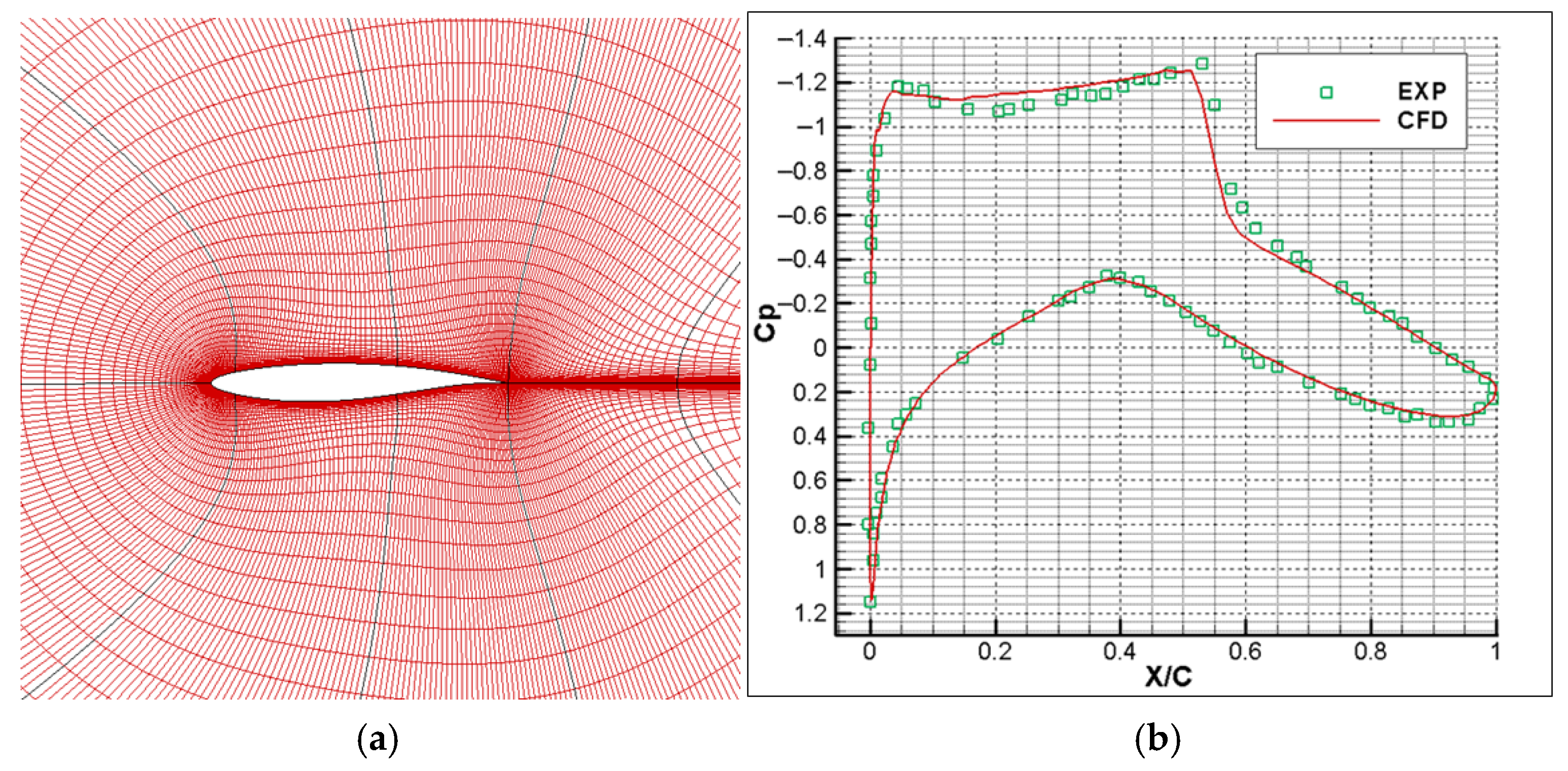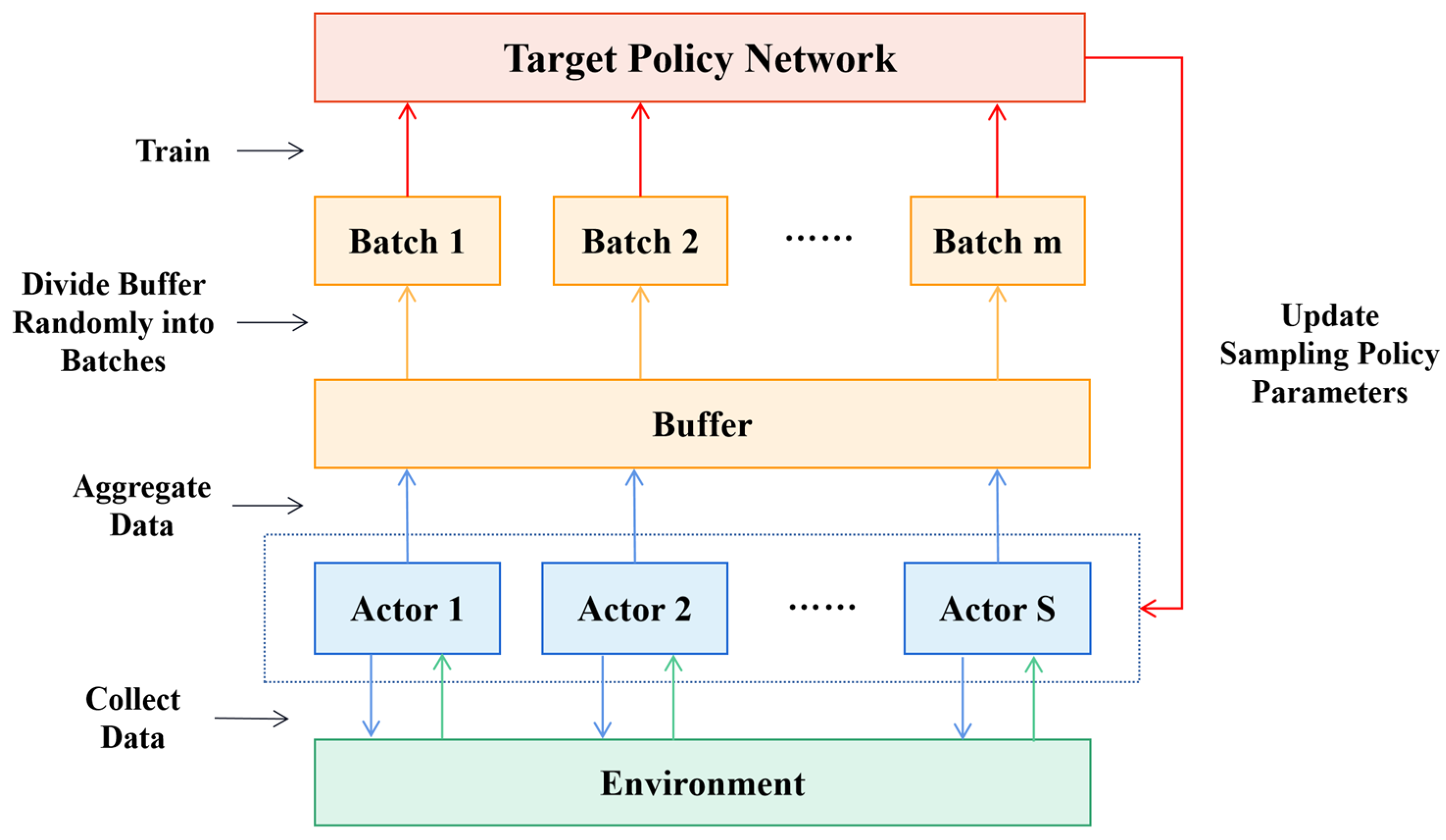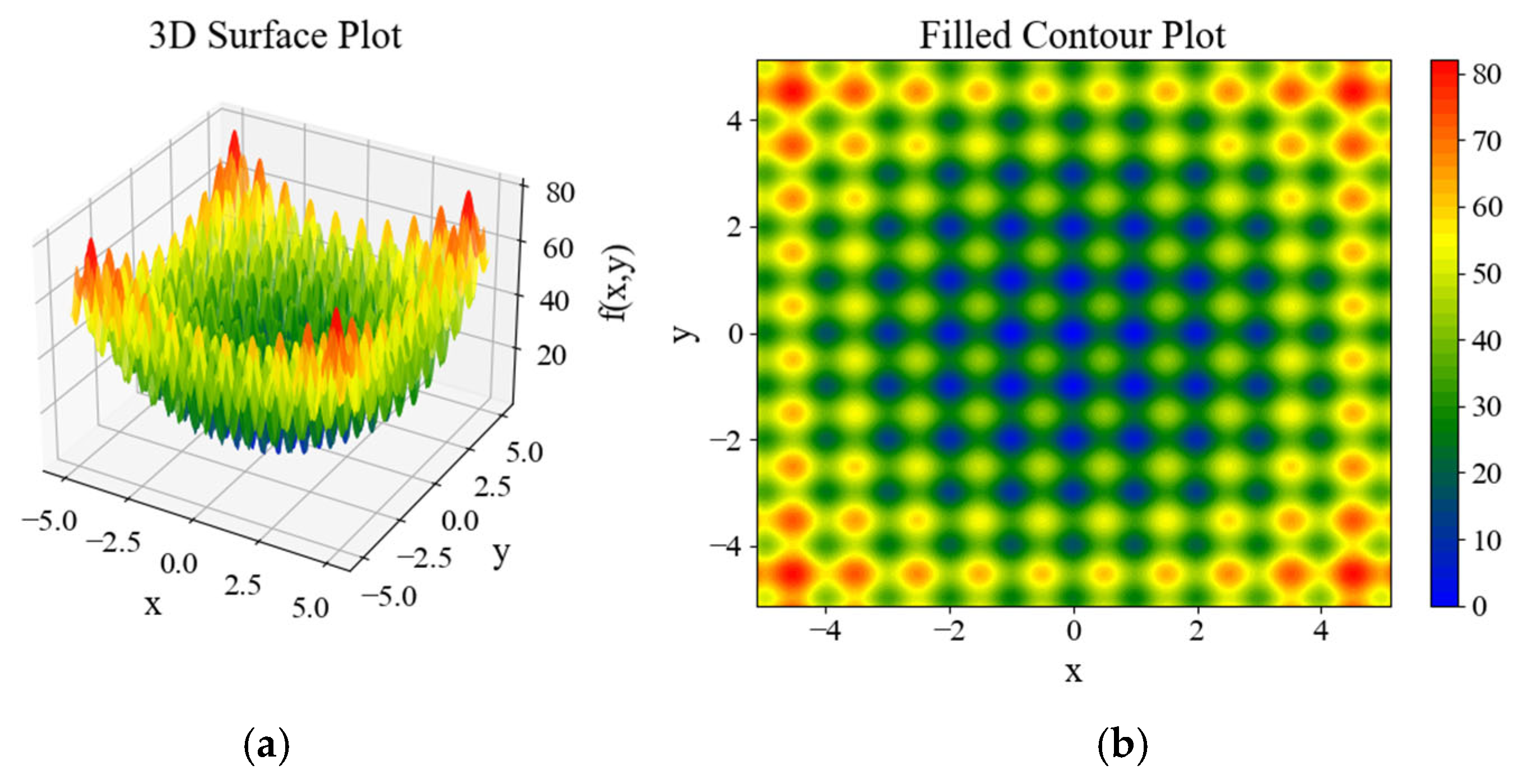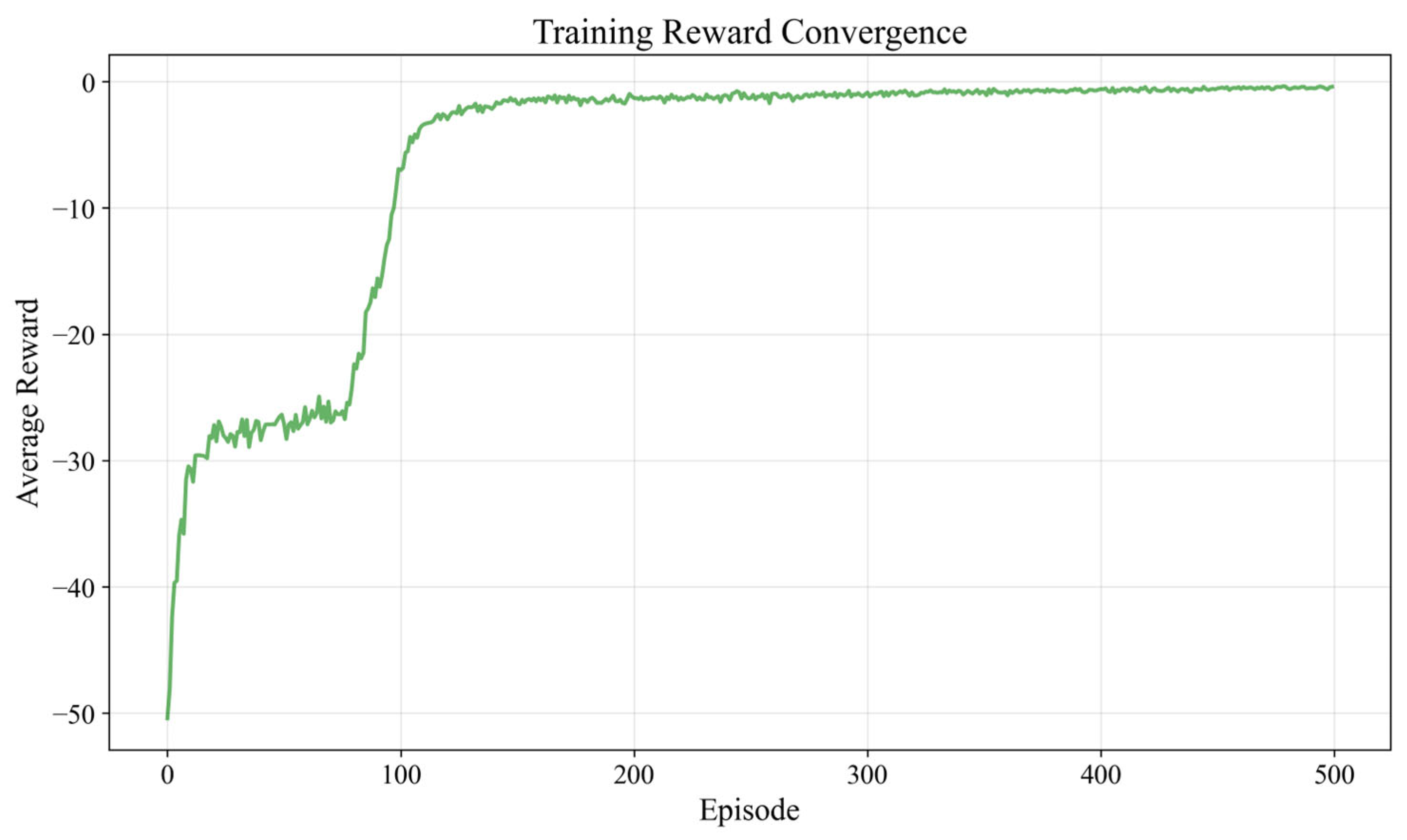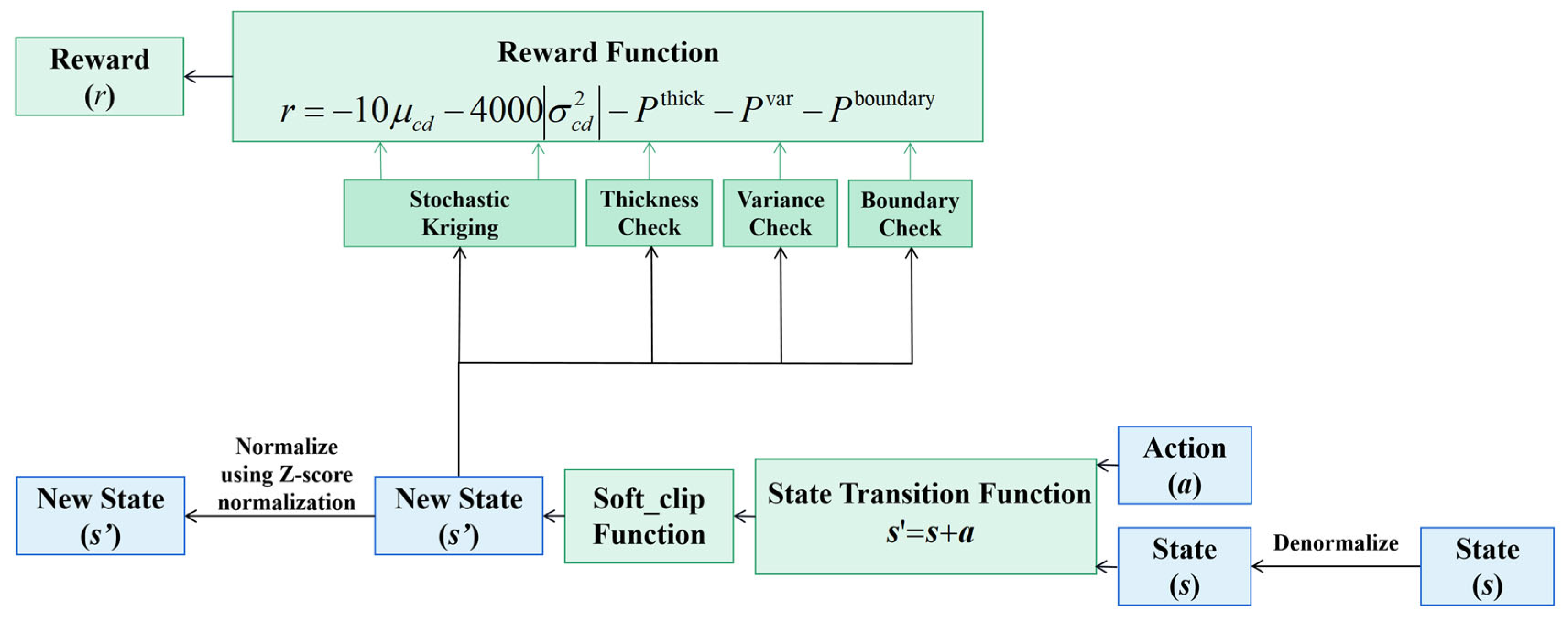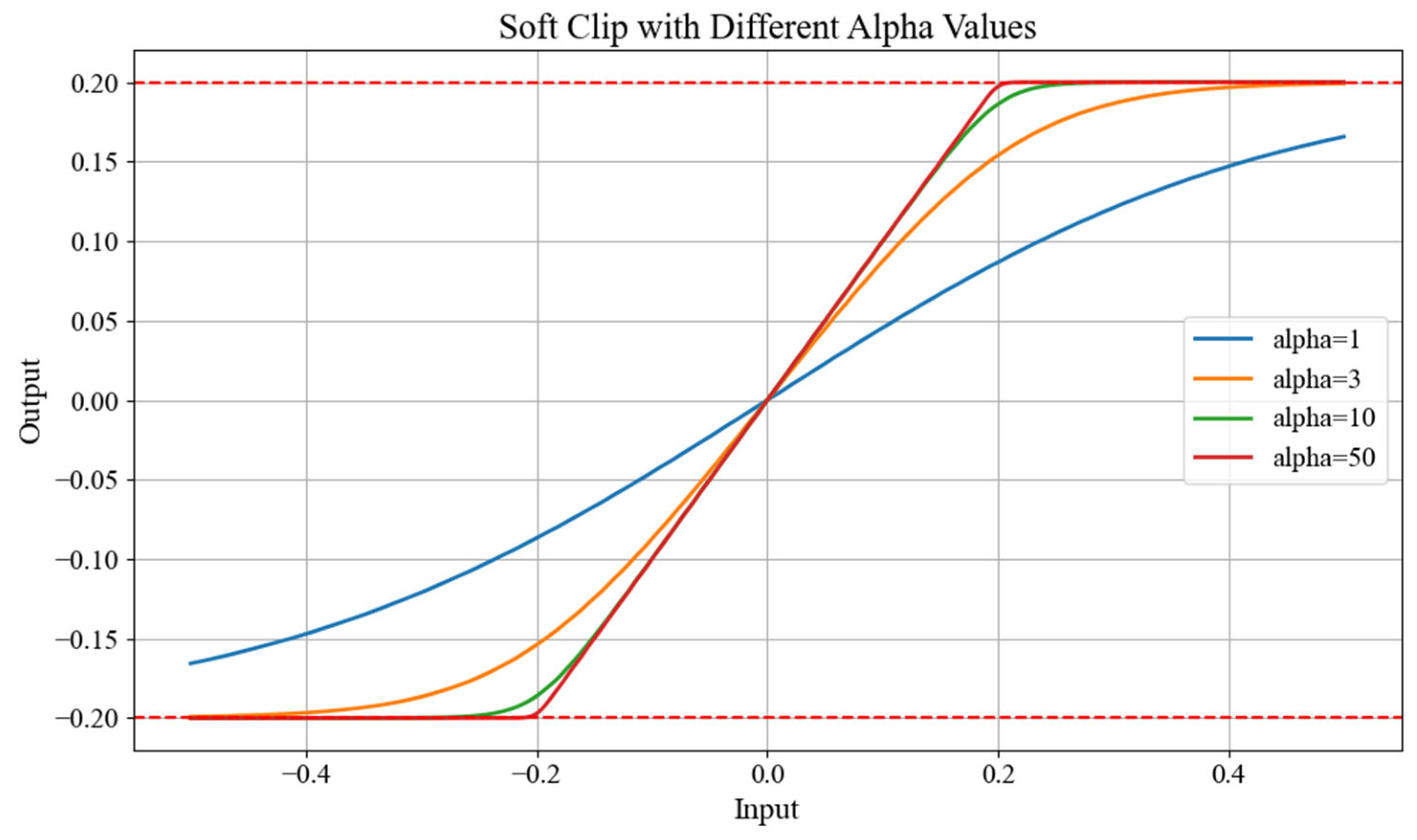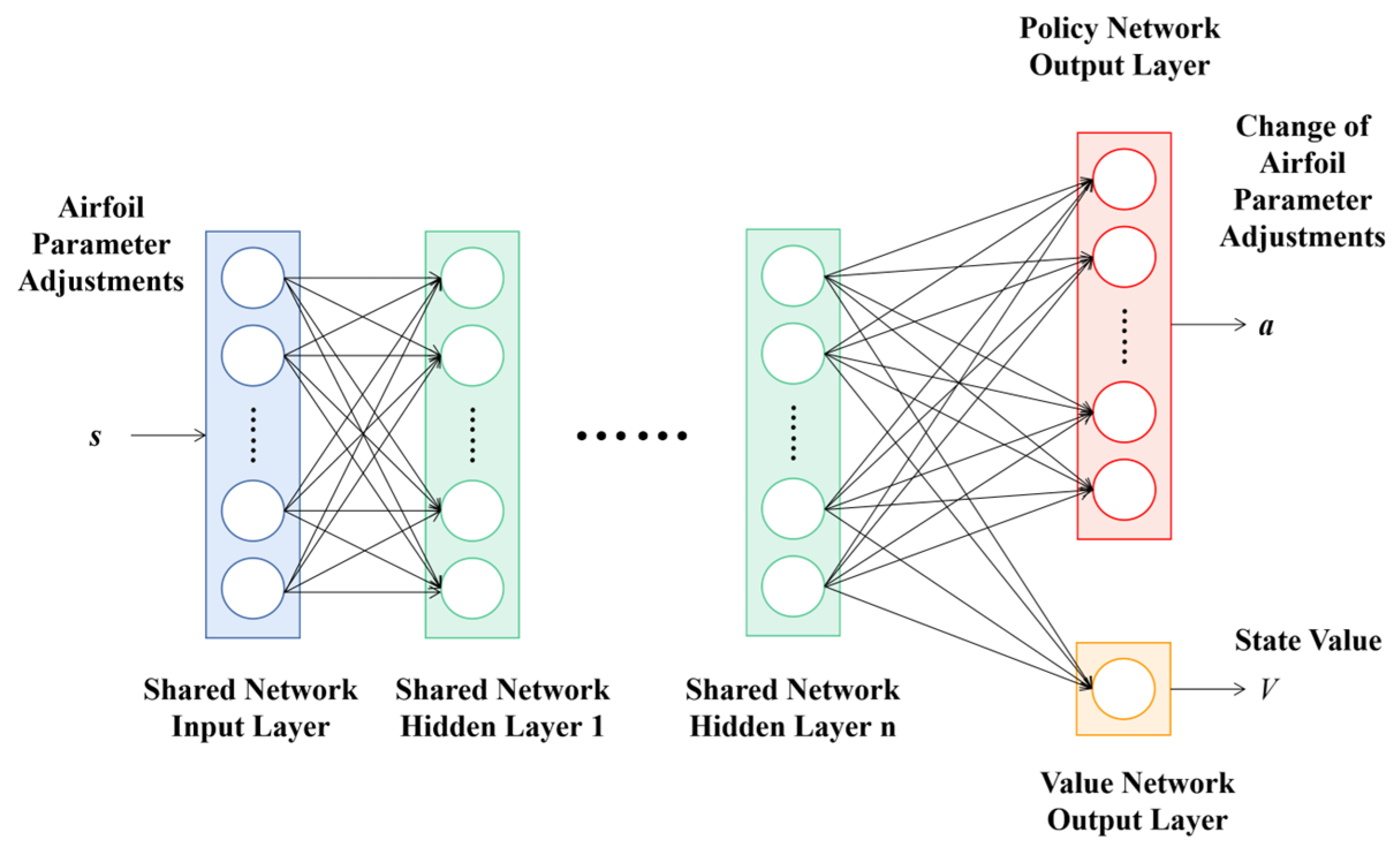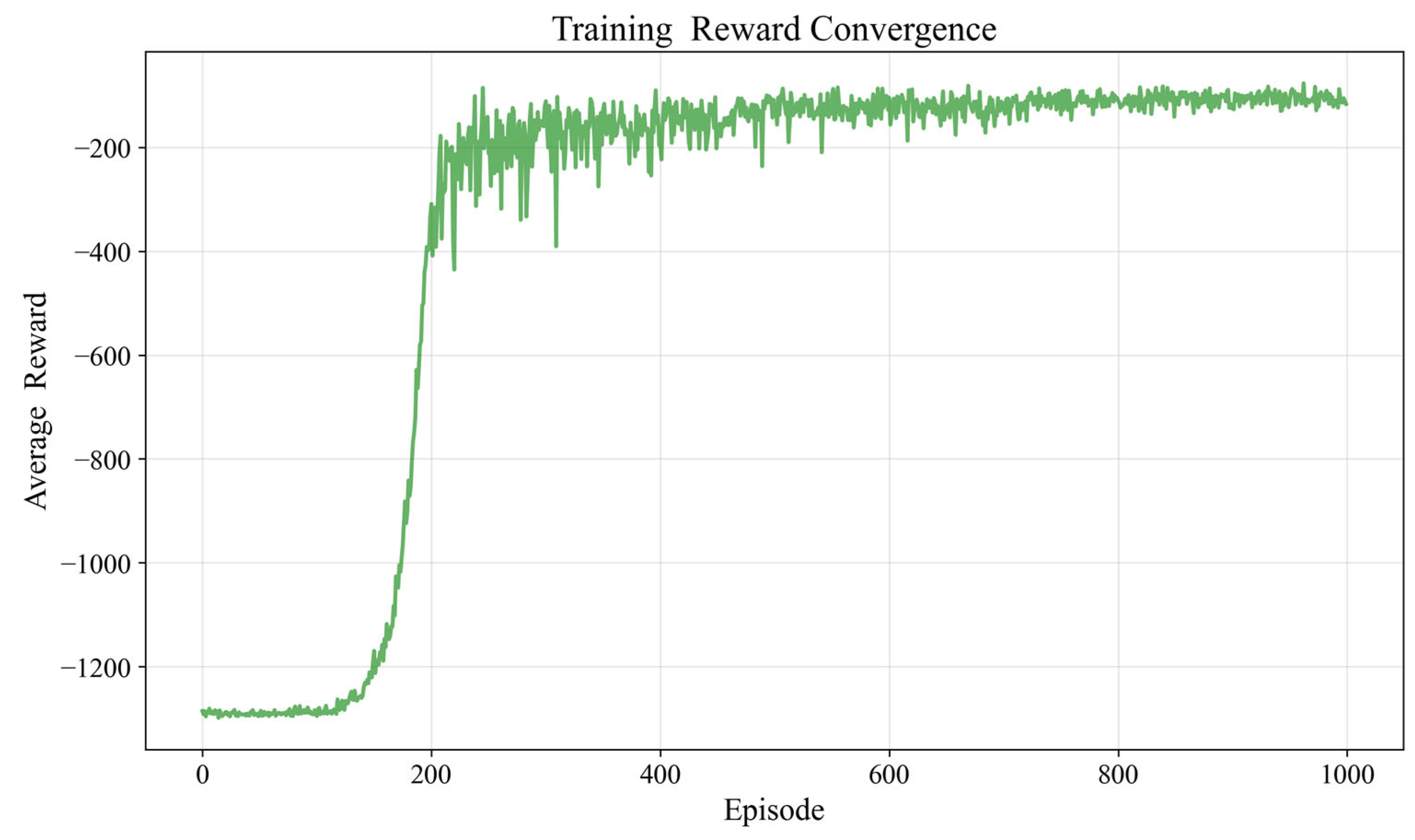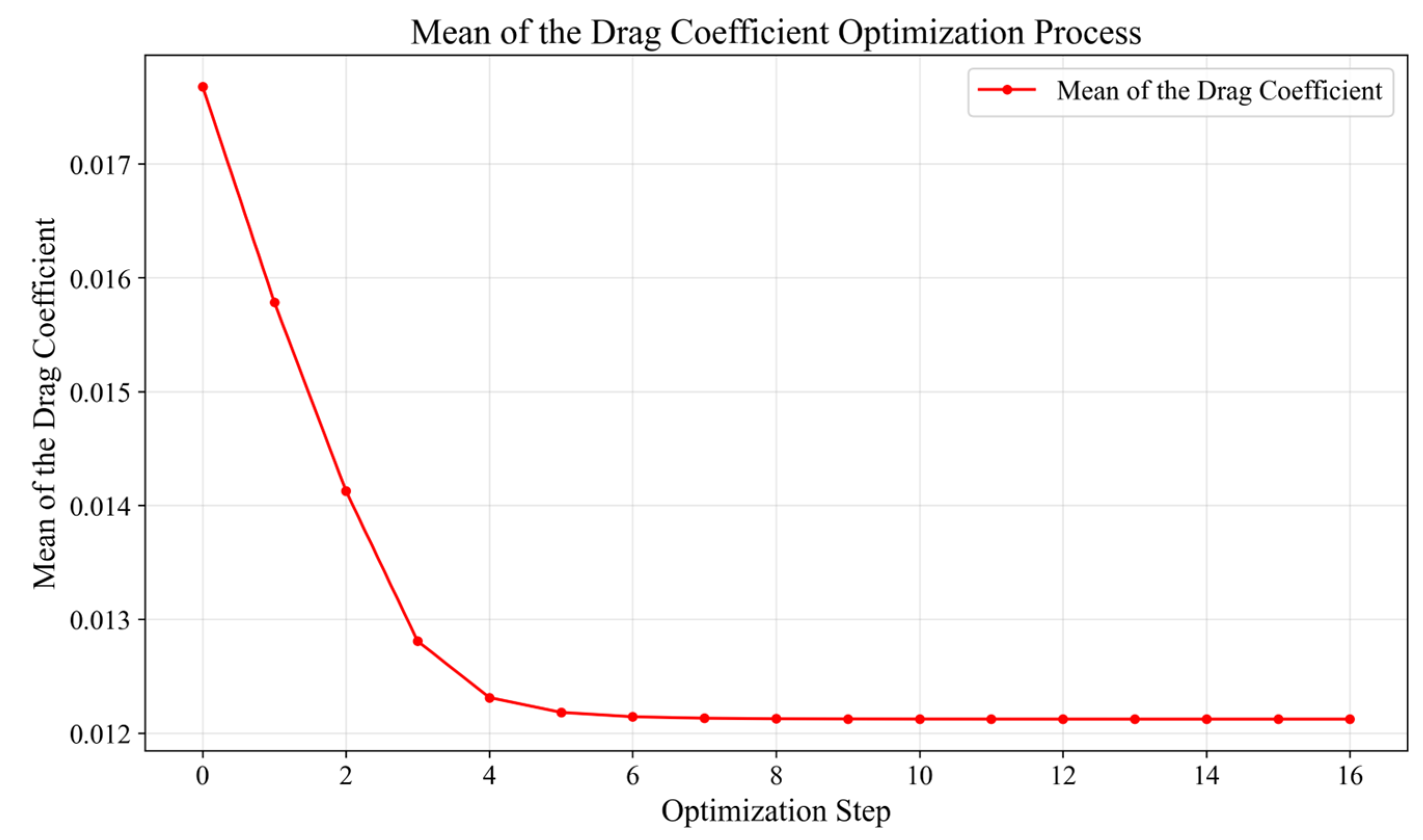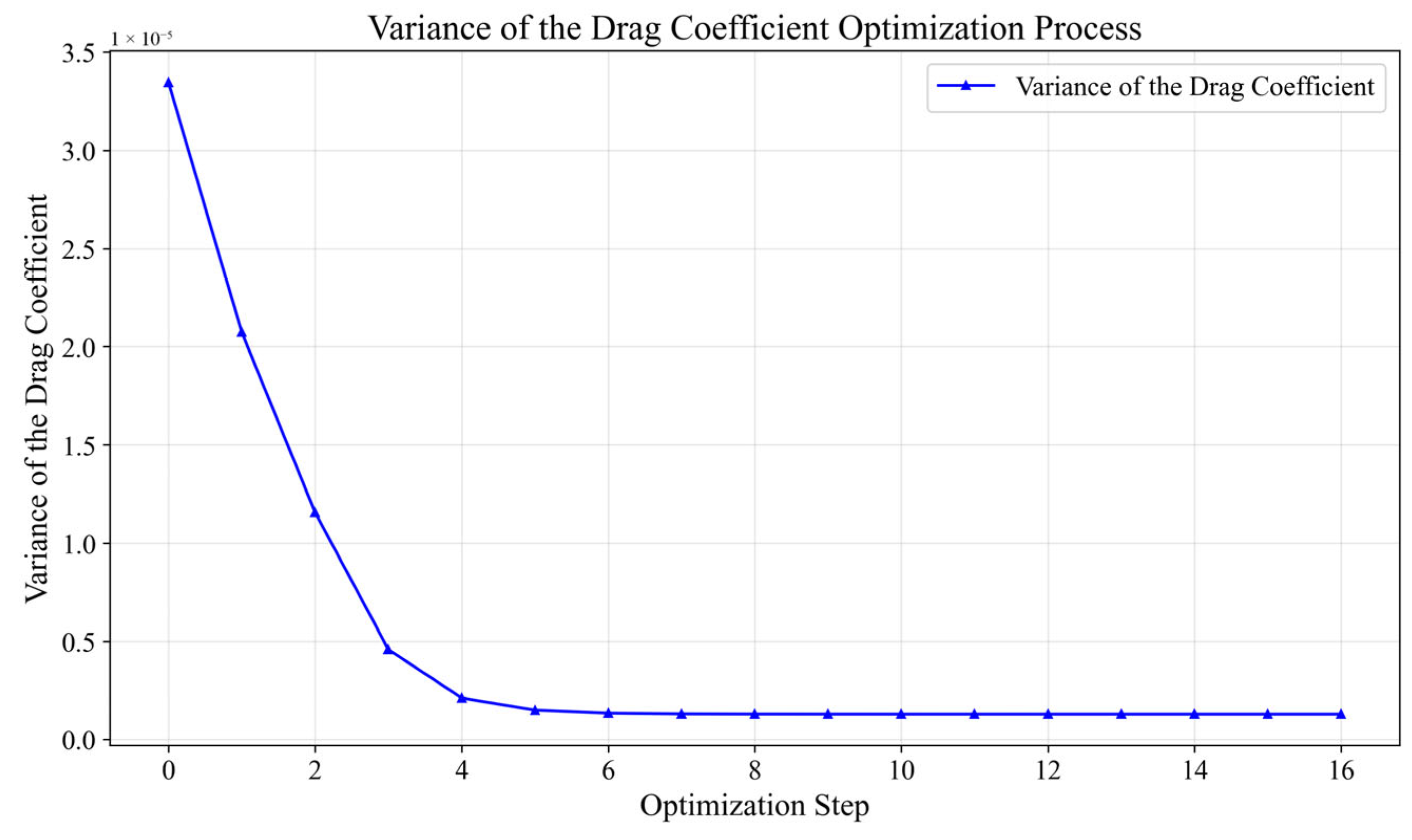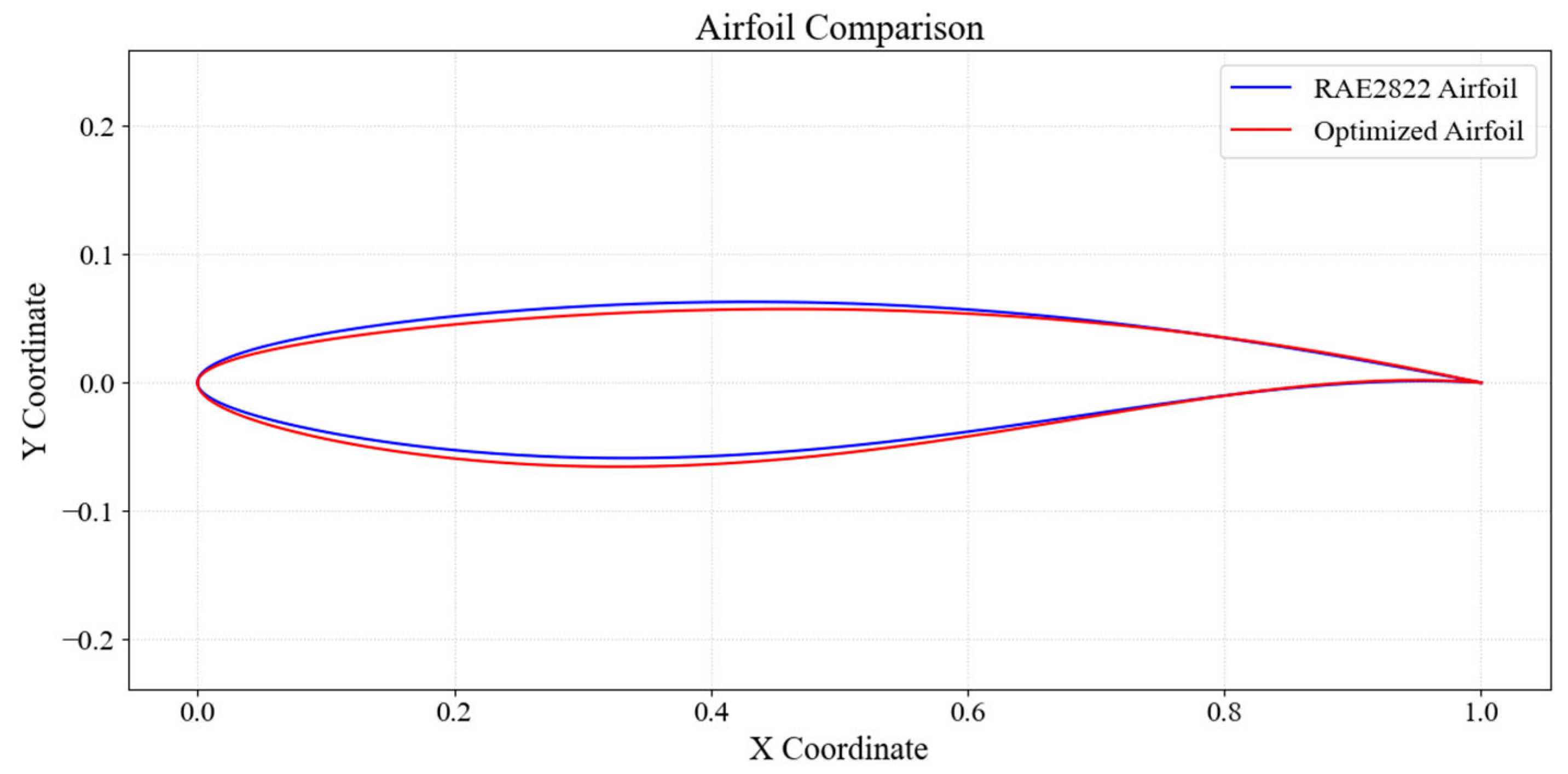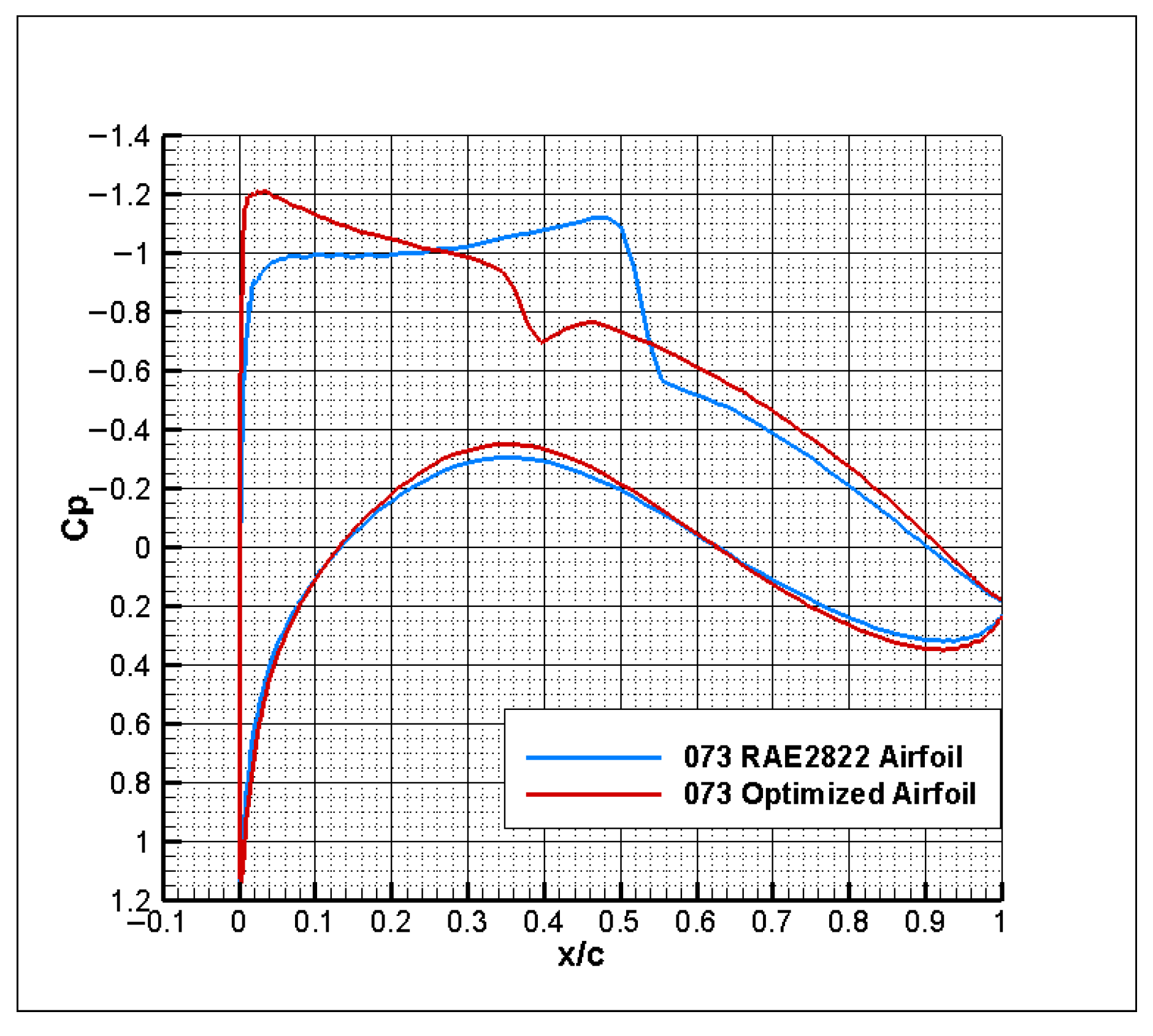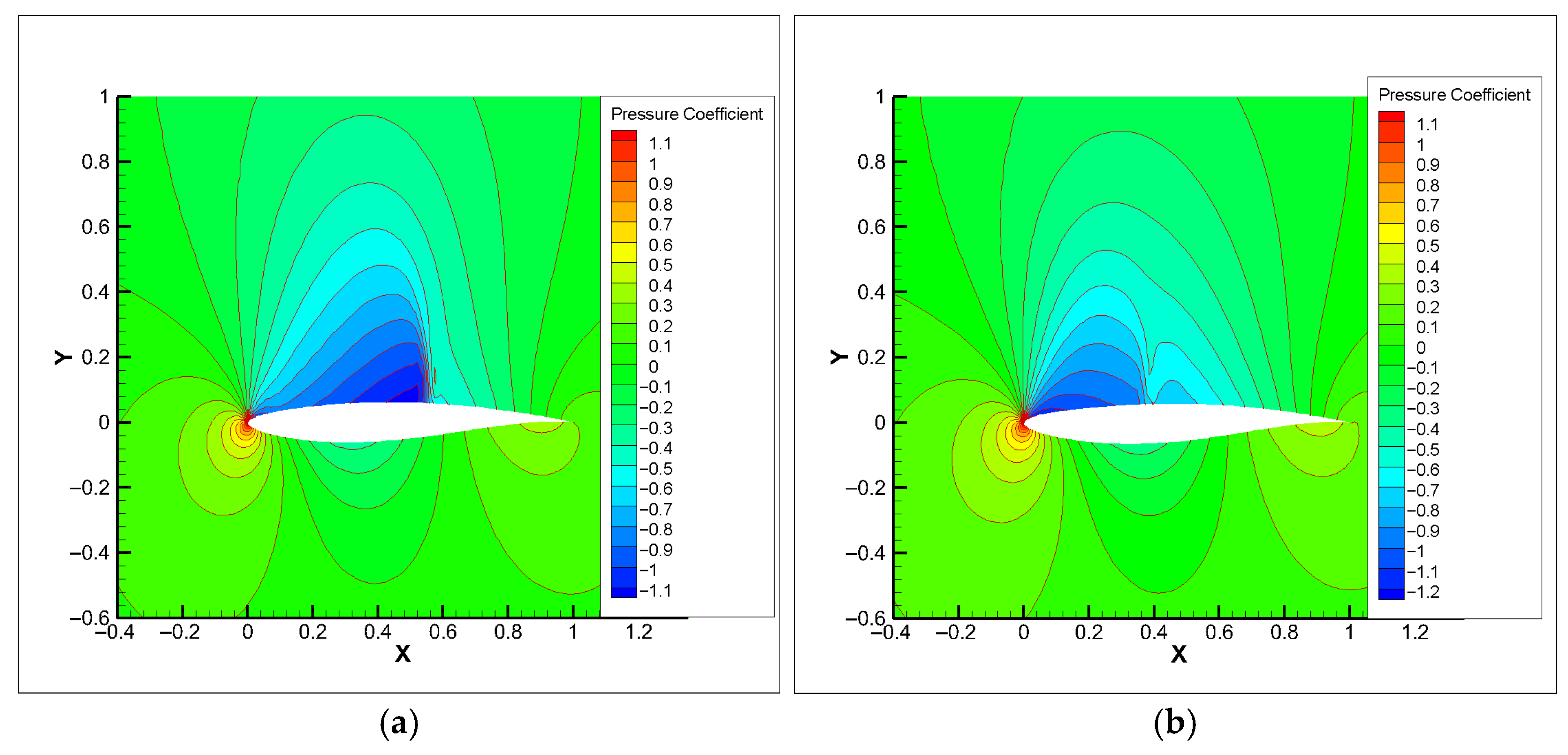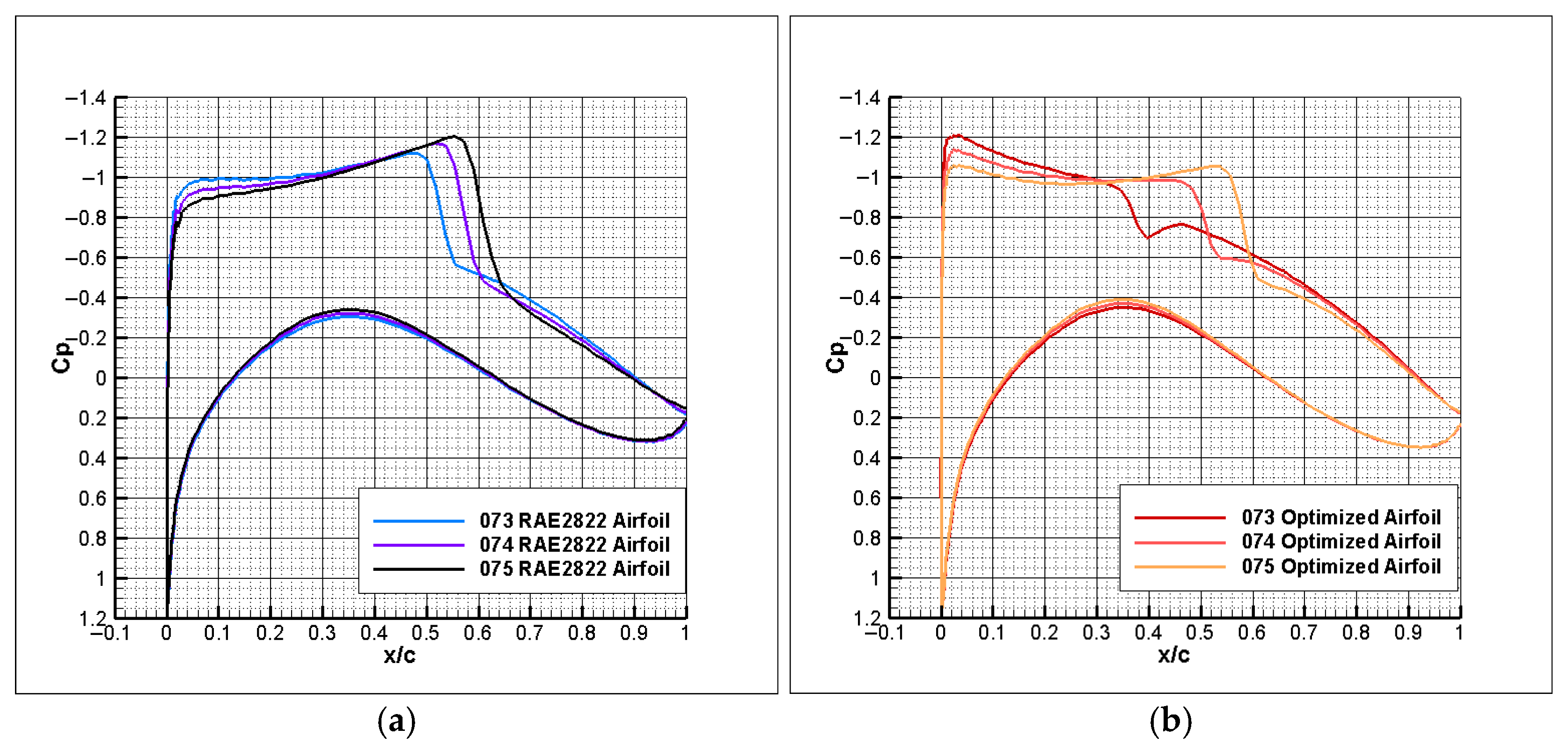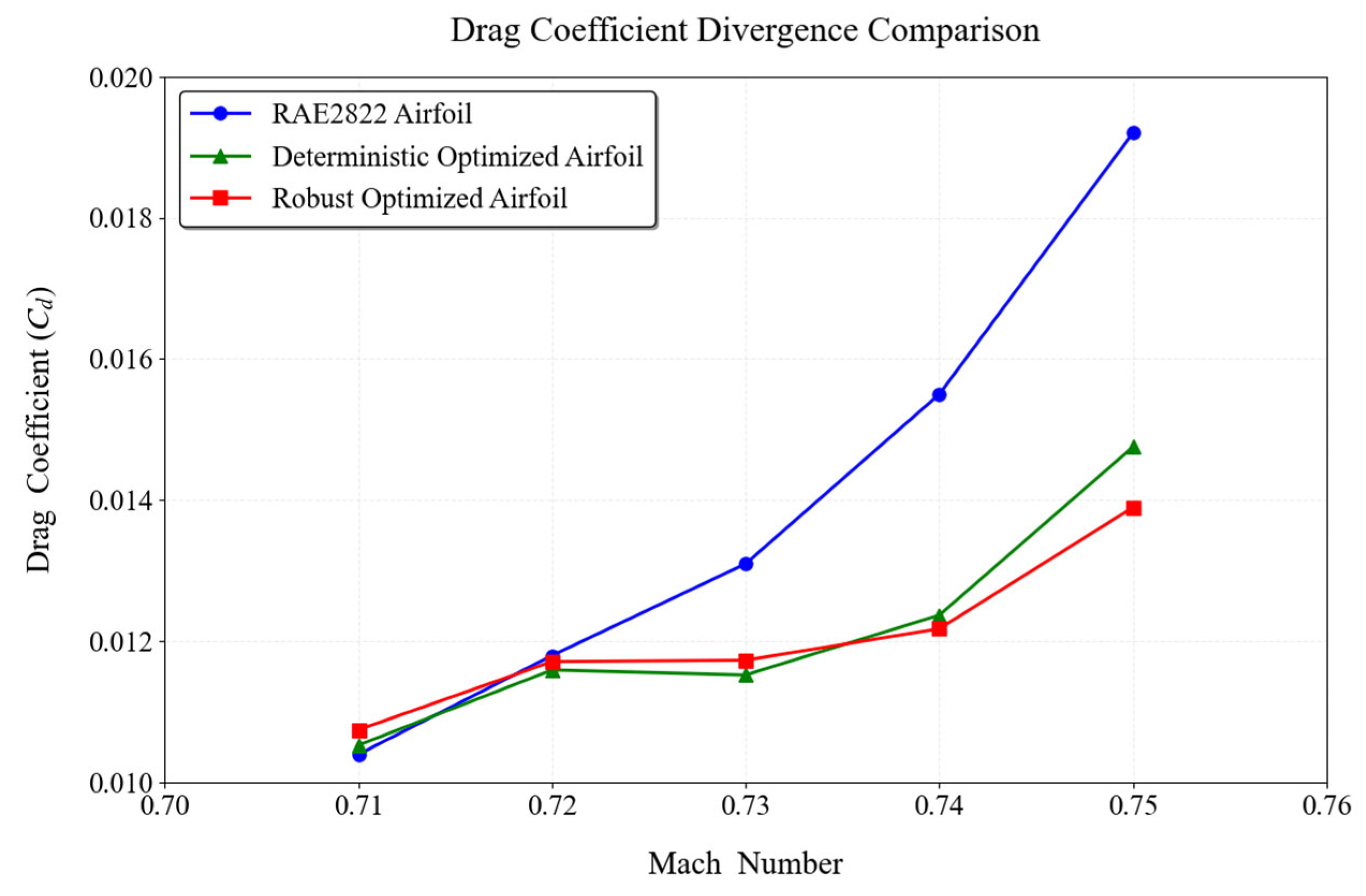1. Introduction
With the rapid advancement of technology, Unmanned Aerial Vehicles (UAVs) are emerging as a transformative force across a wide range of fields, owing to their unique advantages and broad application prospects. They have been widely employed in areas such as meteorological research, disaster early warning, geospatial mapping, and logistics delivery. In the entire lifecycle of an UAV—from design and manufacturing through operation—uncertainty is an objective and unavoidable factor. Examples include variations in structural properties due to the material’s physicochemical characteristics and assembly tolerances; deviations in exterior geometry arising during fabrication, use, or maintenance; changes in takeoff weight, flight altitude, and airspeed during operation; and disturbances in atmospheric parameters such as air density, humidity, and wind speed during flight [
1]. These uncertainty factors make the performance of the designed UAV highly sensitive, potentially leading to severe degradation or even failure, which can result in increased economic costs and mission failure [
2]. If such uncertainties are taken into account and quantitatively assessed during the UAV design phase, their negative impact can be significantly reduced. Design methodologies that explicitly account for uncertainty are commonly called robust design. Robust design seeks to render performance objectives insensitive to small fluctuations in design variables—i.e., to ensure system stability under stochastic influences [
3]. First introduced by Taguchi et al. [
4], robust design theory rapidly gained widespread acceptance in industry and academia due to its significant practical engineering value. Building on Taguchi’s foundation, robust design methodologies evolved systematically and were extended to aerodynamic optimization in the UAV domain [
5]. Robust Aerodynamic Design Optimization (RADO) has thus become a core technology for addressing the multi-source uncertainties inherent in UAV design [
6,
7,
8,
9].
Within RADO, two key areas are uncertainty analysis and optimization algorithms. Reliable uncertainty analysis underpins RADO: only rapid and accurate uncertainty analysis can furnish the data necessary to support the design optimization. An effective optimization algorithm lies at the heart of RADO, interlinking all modules of the process and governing the initiation, execution, and termination of the optimization process.
The essence of uncertainty analysis lies in Uncertainty Quantification (UQ), which provides quantitative estimates of how input uncertainties affect system outputs [
10]. The central challenge is characterizing solutions when deterministic parameters are modeled as random variables—specifically, computing objective function’s mean and variance—along with other statistical information, such as its probability density function. Advances in computer hardware and numerical methods have made Computational Fluid Dynamics (CFD) a mature tool for RADO, offering lower design cost, shorter computational turnaround, and greater versatility than traditional experiments. However, when quantifying uncertainty in a UAV’s aerodynamic performance, each design point must be evaluated under multiple operating conditions, which demands substantial computational resources and leads to very low efficiency. To address this, surrogate-modeling techniques have become prevalent in UAV aerodynamic optimization to supplant time-consuming numerical simulations, enabling rapid estimation of lift and drag coefficients and pressure distributions. Building on this concept, computationally inexpensive surrogate models can likewise be used during UQ in lieu of expensive CFD analyses, thereby markedly improving efficiency. Now surrogate-based UQ methods fall into two categories: Deterministic Metamodel-Based Approaches (DMBA) and Stochastic Metamodel-Based Approaches (SMBA). DMBA requires separate estimation of the mean and variance at each design point, leading to significant computational overhead; moreover, deterministic surrogate models are not inherently tailored to uncertainty modeling and may fail to capture complex stochastic behavior. In contrast, SMBA offers lower computational cost, targeted treatment of uncertainty, and more reliable statistical responses [
11]. Common stochastic surrogate frameworks include Polynomial Chaos (PC) [
12,
13], Stochastic Radial Basis Functions (Stochastic RBF) [
14] surrogate model, and Stochastic Kriging (SK) [
3,
15,
16] surrogate model. The SK surrogate model, as an extension of classical Kriging surrogate model into the stochastic domain, not only retains deterministic Kriging surrogate model’s inherent advantage of addressing spatially uniform uncertainty via the so-called “nugget effect,” but also incorporates both intrinsic and extrinsic uncertainties directly into the model’s Mean Square Error (MSE) formulation, yielding reliable predictions of a system’s mean and variance under uncertainty. This approach has already been applied to RADO of aircraft surfaces [
3,
17]. Consequently, SK surrogate model offers strong performance and promising prospects for the RADO of UAVs.
Conventional optimization algorithms fall into gradient-based and heuristic categories. Although gradient-based optimization algorithms, such as Stochastic Gradient Descent (SGD) [
18] and Limited-memory Broyden–Fletcher–Goldfarb–Shanno with Bound constraints (L-BFGS-B) [
19], exhibit efficiency that is largely independent of the number of design variables, they are prone to becoming trapped in local optima [
20]. Heuristic algorithms—such as Genetic Algorithms (GA) [
21] and Particle Swarm Optimization (PSO) [
22]—are relatively easy to implement and offer strong global search capability, but they suffer from a relatively slow convergence rate and limited scalability with respect to the number of design variables, leading to reduced computational efficiency in high-dimensional design spaces [
23]. Both classes of algorithms have inherent trade-offs. With the rapid development of Artificial Intelligence (AI), AI-powered optimization algorithms are emerging as promising tools for efficient RADO of UAVs. Among them, Reinforcement Learning (RL) algorithms are gaining increasing traction in UAV design applications. RL operates through continuous interaction between an agent and its environment, where the environment provides state and reward signals, and the agent iteratively refines its policy based on this feedback—learning progressively until it converges to an optimal strategy for handling the environment [
24]. Well-known RL methods include Q-learning [
25], State-Action-Reward-State-Action (SARSA) [
26], Deep Deterministic Policy Gradient (DDPG) [
27], Trust Region Policy Optimization (TRPO) [
28], Asynchronous Advantage Actor-Critic (A3C) [
29], and Proximal Policy Optimization (PPO) [
30]. Currently, RL has been primarily applied to control and decision-making tasks in UAV design, such as intelligent air combat [
31,
32], attitude control [
33,
34], trajectory planning [
35,
36], and autonomous obstacle avoidance [
37,
38]. Among RL algorithms, Proximal Policy Optimization with Clipped Surrogate Objective (PPO-Clip) is a widely used variant of the PPO algorithm. By constraining the magnitude of policy updates, it ensures training stability, making it the most prevalent form of PPO. Due to its strong convergence properties, high stability and computational efficiency, PPO-Clip is particularly well-suited for RADO of UAVs.
As the foundational element of an aircraft’s aerodynamic performance, the airfoil—owing to its simple structure and low-dimensional parametric representation—is frequently chosen as the example in studies on RADO. In recent years, extensive research has been conducted on both UQ techniques and optimization algorithms for robust airfoil design. In terms of UQ, DMBA have evolved from Kriging surrogate model to multi-fidelity surrogate model [
39]. Meanwhile, SMBA has progressed from Non-Intrusive Polynomial Chaos (NIPC) [
40] to uncertainty-aware deep learning surrogate models [
41]. On the optimization algorithms, the field has advanced from traditional multi-objective algorithms to gradient-based approaches. The following are representative studies in recent years on RADO of airfoils: Liu et al. (2022) addressed the RADO of a transonic airfoil under Mach number uncertainty by proposing a novel framework that combined NIPC for UQ, Kriging surrogate modeling, a Lower Confidence Bound (LCB) infill criterion, and the GlobalSearch optimization algorithm. This integrated strategy significantly enhanced aerodynamic robustness—particularly through drag reduction—while reducing the computational cost to just 20.76% of that incurred by conventional deterministic methods [
42]. Jofre et al. (2022) proposed an SGD framework incorporating an AdaGrad-style adaptive gradient method, explicitly formulated to manage both aleatoric and epistemic uncertainties in aerodynamic airfoil design. By using a small number of random samples per iteration to estimate both the performance metric and its gradient—and embedding both mean and variance into the optimization objective—they performed robust optimization of the NACA 0012 airfoil across different Reynolds numbers and RANS turbulence models. The computational cost was only a modest factor higher than that of a single-point deterministic design, yet the method substantially reduced uncertainty, achieving more robust aerodynamic performance [
43]. Chen et al. (2024) proposed a data-driven framework based on Distributionally Robust Optimization (DRO) to address aerodynamic shape design under uncertainty in flight conditions. The framework constructs ambiguity sets via
divergence to quantify distributional shifts. By theoretically linking DRO with Taguchi methods, it enhanced design robustness. A constrained optimization problem was solved using a stochastic gradient algorithm. In transonic turbulent-flow airfoil design experiments, the method delivered promising preliminary results, improving robustness against distributional shifts [
44]. Sharpe et al. (2025) developed NeuralFoil, a hybrid physics-informed machine learning framework designed to address the convergence failures and non-smooth behavior that hinder traditional RADO tools such as XFoil. It introduces a novel surrogate model UQ technique (termed analysis confidence) embedded within a physics-constrained neural architecture. Leveraging its
continuity and compatibility with automatic differentiation, NeuralFoil enables gradient-based optimization. Quantitatively, when matching XFoil-level accuracy, it achieves 8–30× speedups for single-point analyses and up to 1000× acceleration in batched, multipoint evaluations, all while maintaining mean drag prediction errors as low as 0.37%. Within seconds, it can generate optimized airfoils that closely resemble expert-designed configurations, thus substantially enhancing the robustness and efficiency of aerodynamic design workflows [
45]. Previous studies have provided a solid foundation for the further development of RADO methodologies for airfoils and have inspired the research direction of this paper.
To overcome the key challenges of high computational cost in UQ and the inefficiency of conventional optimization algorithms in achieving rapid optimization in the current RADO methodologies of UAVs, this paper proposed a new methodology that combines a trained SK surrogate model for rapid and accurate UQ of UAV’s aerodynamic performance with the PPO-Clip algorithm for efficient RADO. Using the commonly employed RAE2822 airfoil for UAVs under Mach number perturbations as a case study, the effectiveness of the proposed methodology was validated through analysis of the optimization results.
The rest of the paper is organized as follows.
Section 2 presents the RADO process for UAV airfoils, including the determination of optimization objectives and constraints, the parameterization method for the airfoil, and an overview of the parameter optimization.
Section 3 introduces the SK surrogate model used in parameter optimization. A SK surrogate model meeting the required accuracy was trained using Maximin Latin Hypercube Sampling (MM-LHS) combined with the Expected Improvement (EI) infill criterion.
Section 4 describes the PPO-Clip algorithm applied in the parameter optimization, detailing the design of the reward and state functions tailored to the RADO objectives and constraints, as well as structural modifications made to the algorithm to enhance its stability and reliability.
Section 5 applies the trained SK surrogate model and the modified PPO-Clip algorithm to perform RADO of the RAE2822 airfoil under Mach number perturbations. The optimization results were analyzed and compared with those obtained using L-BFGS-B and PSO algorithms, thereby validating the reliability and efficiency of the proposed RADO methodology.
Section 6 presents the conclusions and future outlook.
2. Robust Aerodynamic Design Optimization Process for UAV Airfoils
The RADO process for UAV airfoils is illustrated in
Figure 1. It primarily consists of three components: determination of optimization objectives and constraints, airfoil parameterization, and parameter optimization. First, the optimization objectives and constraints are determined based on the RADO problem. Next, the airfoil geometry is parameterized to enable quantitative optimization. Finally, parameter optimization is performed, wherein robust aerodynamic analysis and constraint evaluation yield an integrated optimization objective value integrating both optimization objectives and constraints. This value is iteratively optimized using the PPO-Clip algorithm to identify the optimized airfoil parameters. This section provides a description of each component.
2.1. Determination of Optimization Objectives and Constraints
This paper addresses the issue of atmospheric uncertainties encountered by turbojet-powered UAVs during transonic cruise flights. To minimize the impact of Mach number variations on aerodynamic drag and to enhance cruise efficiency and endurance, an RADO of the UAV airfoil was conducted.
The RADO problem of the UAV airfoil can be formulated as:
The RADO problem of the UAV airfoil considers Mach number as an uncertain factor in the flight conditions. The perturbation interval of the Mach number is set to 0.71 to 0.75, reflecting the typical range encountered during high-altitude, long-endurance cruise missions. Here, represents the assumption that the Mach number is uniformly distributed in the interval [0.71, 0.75]. The objective of optimization is to minimize both the mean of the drag coefficient and the variance of the drag coefficient . Reducing the mean of the drag coefficient improves the cruise efficiency and endurance of the UAV, while reducing the variance enhances the stability of flight performance under varying atmospheric conditions. This constitutes a multi-objective optimization problem, and refers to the use of either the weighted sum approach or by establishing a multi-objective optimization mode to address it. There are four constraints:
Constant Lift Coefficient Limit: indicates that the lift coefficient of the UAV airfoil is fixed at 0.68. Based on this constraint, RADO is carried out for the UAV airfoil.
Airfoil Thickness Limit: the maximum thickness of the airfoil must be no less than 0.12 to ensure adequate aero-structural strength and safety margins under the UAV’s lightweight structural design.
Drag Coefficient Variance Limit: the variance of the drag coefficient should be no less than to prevent numerical instability during the computation process caused by excessively small variance.
Airfoil Parameter Variation Range Limit: the variation range of the airfoil parameters (i.e., airfoil parameter adjustments) is restricted to in order to control the extent of optimization. This prevents excessive parameter changes that could hinder convergence or lead to unpredictable aerodynamic characteristics and manufacturing challenges for the UAV airfoil.
Since this paper focused on optimizing the RAE2822 airfoil, the description of the new airfoil was based on the approach of “baseline airfoil parameters + airfoil parameter adjustments,” i.e., new airfoil parameters = RAE2822 baseline airfoil parameters + airfoil parameter adjustments. The airfoil parameter adjustments serve as the design variables in the optimization process.
2.2. Airfoil Parameterization
To accurately characterize the UAV airfoil geometry using a limited number of variables, this paper employed the Class-Shape Transformation (CST) parameterization method [
46,
47] which features a small set of control parameters with clear geometric interpretations and strong modeling capability [
48]. In this paper, the airfoil geometry was described using 9 design variables, each corresponding to the weight coefficient of a Bernstein polynomial. Specifically, the upper surface of the airfoil is represented by a third-order Bernstein polynomial with 4 variables, while the lower surface is described by a fourth-order polynomial with 5 variables. As an illustrative example,
Table 1 presents the parameterization of the RAE2822 airfoil, demonstrating how each of the 9 variables influences specific geometric features.
The CST parameterization method is implemented as part of an in-house code, and its effectiveness was validated in
Figure 2.
The RAE2822 airfoil was selected as the test case.
Figure 2a,b showed the upper and lower surfaces of the airfoil before and after CST parameterization, respectively. As observed, this method could effectively approximate the target airfoil. It also showed that the UAV airfoil could be described with considerable accuracy using fewer variables, which is highly beneficial for UAV design optimization within limited computational resources.
2.3. Overview of Parameter Optimization
The core of the parameter optimization module lies in leveraging the SK surrogate model and the PPO-Clip algorithm to efficiently identify UAV airfoil designs with strong robustness to Mach number perturbations, while satisfying engineering constraints.
The parameter optimization module is composed of robust aerodynamic analysis, constraint evaluation, integrated optimization objective calculation, and the PPO-Clip algorithm optimization. The integrated optimization objective consists of two optimization objectives (minimizing the mean and variance of the drag coefficient) and three constraints (airfoil thickness limit, drag coefficient variance limit, and airfoil parameter variation range limit). The constant lift coefficient limit is directly enforced by the CFD solver, which will be introduced in
Section 3, through dynamic adjustment of the cruise angle of attack. Therefore, it does not need to be explicitly included in the computation of the integrated optimization objective or in the subsequent training of the SK surrogate model. Parameter optimization aims to find the airfoil parameter adjustments and updated airfoil parameters that minimize the integrated optimization objective.
For the two optimization objectives, the SK surrogate model is used to compute the mean and variance of the drag coefficient for robust aerodynamic analysis. A weighted-sum approach is applied by assigning different weights to the mean and variance terms of the drag coefficient, thereby transforming the multi-objective optimization problem into a single-objective one. For the three constraints, the designed ThicknessCheck function, VarianceCheck function, soft_clip function, and BoundaryCheck function are used for constraint evaluation. Specifically, the airfoil thickness limit and drag coefficient variance limit are handled by applying penalty terms to individuals that exceed the limits, with the ThicknessCheck function and VarianceCheck function used to obtain the thickness penalty term and variance penalty term, respectively. The airfoil parameter variation range limit is managed using the soft_clip function for soft clipping, and the BoundaryCheck function is used to obtain boundary penalty term to reduce boundary accumulation.
The PPO-Clip algorithm interacts continuously with the environment using the above information to train the optimal policy and obtain the optimized airfoil parameter adjustments and optimized airfoil parameters that meet the integrated optimization objective. The SK surrogate model is employed to rapidly estimate the mean and variance of the drag coefficient, which facilitates the training of the optimal policy represented by a neural network. The detailed parameter optimization process, including the definitions of the ThicknessCheck function, VariancePenalty function, soft_clip function and BoundaryPenalty function will be introduced in
Section 4.
3. Construction and Training of the Stochastic Kriging Surrogate Model
Traditional CFD-based UQ is computationally expensive and cannot meet the demand for evaluating large numbers of samples required in the RADO of UAVs. The SK surrogate model, as an efficient stochastic modeling approach, significantly reduces the computational burden associated with evaluating UAV airfoil performance under uncertain flight conditions. In the RADO process for UAV airfoils, the SK surrogate model was employed to quantify the optimization objectives (i.e., the mean and variance of the drag coefficient) for robust aerodynamic analysis. Therefore, constructing and training an accurate SK surrogate model is crucial. This section first provides a brief overview of the construction method for the SK surrogate model, followed by a detailed description of its training process. The training involved sampling using the MM-LHS, assessing the fitting accuracy of the SK model using an error function, and refining the model through the EI infill criterion. Finally, the accuracy of the mean and variance predictions of the drag coefficient from the SK surrogate model was validated using the mean relative error and mean logarithmic error.
3.1. The Construction of the Stochastic Kriging Surrogate Model
The SK surrogate model is a variant of the Kriging surrogate model, specifically designed for uncertainty analysis, and belongs to the class of stochastic models. It is efficient and computationally cost-effective when dealing with problems involving multiple random variables. For most practical uncertainty problems, the uncertainty is inherently unknown and typically inferred through analysis of repeated samples. Based on this, Wang [
3] proposed the SK surrogate model based on finite sample sets and introduced intrinsic and extrinsic uncertainties to reconstruct the model’s MSE problem and provided statistical derivations building upon Kriging theory.
The simulation response
at input state
is modeled as:
where
is a constant mean,
represents the extrinsic uncertainty, and
denotes the intrinsic uncertainty (simulation noise).
To account for finite sampling, each design point
is evaluated with
independent replications, yielding the sample mean
and the sample variance
The extrinsic correlation structure is captured via the covariance matrix
, constructed using the Gaussian correlation function:
where
are correlation length-scale parameters.
The intrinsic uncertainty is modeled by a diagonal matrix:
The Best Linear Unbiased Predictor (BLUP) for an unobserved state
is then expressed as
where
is the vector of covariances between
and the observed states. The corresponding MSE of the predictor is given by
To further quantify the uncertainty, the intrinsic variance at
,
is predicted as
where
is the mean of the intrinsic variances, and
,
,
denote the covariance structures of the intrinsic uncertainties.
The model parameters
,
, and
are estimated via Maximum Likelihood Estimation (MLE), by maximizing the log-likelihood function:
An important feature of this formulation is its adaptive interpolation-regression capability: as the number of replications , , and the predictor converges to the classical interpolating Kriging model. Conversely, for finite or noisy data, the predictor smoothly transitions to a regression model, providing robust predictions under varying uncertainty levels. This makes the SK model particularly suitable for uncertainty-aware UAV aerodynamic optimization, where both prediction accuracy and UQ are essential.
3.2. The Training of the Stochastic Kriging Surrogate Model
3.2.1. Training Process
The high-fidelity trained SK surrogate model serves as the computational foundation for RADO of UAV airfoils. The training of the SK surrogate model primarily involves sample collection, surrogate model fitting, calculating the error function to assess fitting accuracy, and, if the accuracy is insufficient, adding new samples based on the infill criterion and retraining the model with the updated training set. The schematic of the training process is shown in
Figure 3.
First, the samples are collected using the MM-LHS to obtain both the test set and the initial training set. The test set is used to calculate the error function and assess the fitting accuracy of the SK surrogate model to decide whether to output the model. The training set is used to train the SK surrogate model. After fitting the SK surrogate model, the estimated values for the samples in the test set are computed, and the error function is calculated. If the error is below a specified threshold, the SK surrogate model is output. Otherwise, the EI infill criterion is applied to add new samples to the training set, updating it and refitting the SK surrogate model. This process continues until the required model accuracy is achieved or the maximum number of iterations is reached.
3.2.2. Sample Collection
To enhance the uniformity of sample distribution, this paper adopted an improved Latin Hypercube Sampling (LHS) strategy—specifically, the MM-LHS [
49]. A total of 1000 samples were generated for the initial training set, 800 for the test set. Each sample includes a 9-dimensional vector of airfoil parameter adjustments, the mean and variance of the drag coefficient, as well as thickness and variance penalty terms. The airfoil parameter adjustments were sampled from a domain
, which is slightly larger than the target design space
, in order to improve sample uniformity within the UAV-critical target domain and enhance prediction accuracy near its boundaries. The mean and variance of the drag coefficient were obtained by invoking a CFD solver, while the penalty terms were computed using the custom-designed ThicknessCheck and VarianceCheck functions, which will be described in detail in
Section 4.
The mean and variance of the drag coefficient for each sample in design space were obtained by invoking the CFD solver to compute the drag coefficients averaged over Mach numbers ranging from 0.71 to 0.75. The solver employed the Reynolds-Averaged Navier–Stokes (RANS) equations as the numerical framework. The Roe scheme [
50], a representative method of Flux Difference Splitting (FDS) in upwind schemes, was employed for spatial discretization. An implicit time-marching scheme was adopted, and for steady-state problems, the implicit approximate factorization method was employed. The turbulence model adopted is the two-equation
SST model [
51]. A structured mesh was utilized, and grid deformation was managed using Volumetric Spline Interpolation Techniques (VSIT) [
52]. Boundary conditions include no-slip and adiabatic wall assumptions, with a zero normal pressure gradient. Riemann invariants were applied at far-field boundaries to ensure non-reflecting conditions, and symmetry boundary conditions were used to reduce computational costs. The CFD solver, implemented as an in-house code, was validated in
Figure 4 through a representative transonic flow simulation over the RAE2822 airfoil.
Figure 4a shows the computational mesh of the airfoil, consisting of 80,000 grid points.
Figure 4b presents a comparison between the results computed by the CFD solver and the experimental data under the conditions of
,
,
. As shown in
Figure 4b, the CFD results agreed well with the experimental measurements, demonstrating the solver’s accuracy and providing a solid data foundation for constructing a reliable stochastic surrogate model.
3.2.3. Calculation of the Error Function
After completing sample collection and SK surrogate model fitting, it is necessary to assess the accuracy of the SK surrogate model to determine whether to output the model directly or use the infill criterion to add new samples to the training set to improve the model’s accuracy. The accuracy of the SK surrogate model was assessed using an error function, calculated using the samples from the test set.
The error function is defined as follows:
where
is the number of samples in the test set,
is the predicted target value for the
-th sample in the test set predicted by the SK surrogate model, and
is the true target value for the
-th sample in the test set calculated by the CFD solver.
The formula for
is as follows:
where
and
are the mean and variance of the drag coefficient for the
-th sample in the test set predicted by the SK surrogate model, respectively. Since the mean of the drag coefficient is on the order of
, while the variance of the drag coefficient ranges from
to
, a significant difference in magnitude exists between the two. To balance this disparity, a weighting factor of 10 is assigned to the mean of the drag coefficient, and a weighting factor of 4000 is applied to the variance of the drag coefficient.
The use of absolute values ensures non-negativity of this term, preventing cancelation effects caused by potential negative values due to numerical errors.
The formula for
is as follows:
where
and
are the mean and variance of the drag coefficient for the
-th sample in the test set calculated by the CFD solver, respectively.
As the purpose of the error function is to assess the accuracy of the surrogate model, no penalty terms are included in the error function.
3.2.4. Infill Criterion
This paper enhanced the accuracy of the surrogate model by iteratively enriching the training set using an infill criterion. This enables the construction of a sufficiently accurate surrogate model with relatively few but computationally expensive CFD simulations, which directly determines the overall efficiency and feasibility of the RADO of UAV airfoils. Specifically, the EI [
53] infill criterion was adopted due to its strong global search capability and scalability. The EI infill criterion quantifies the expected improvement in the vicinity of the current best solution and selects the candidate point with the highest potential to enhance the objective function performance as the next sampling point.
In each iteration of the EI infill criterion for training the SK surrogate model, a candidate sample set consisting of 100 samples—comprising only the airfoil parameter adjustments—was generated using MM-LHS. The sample with the highest EI value within the candidate set was then selected and added to the training set for retraining the SK surrogate model.
The EI value for the
-th candidate sample is calculated as:
where
is the best integrated optimization objective value for the samples in the current training set, incorporating both the optimization objective and the constraints;
is the predicted integrated optimization objective value for the -th candidate sample;
is the standard deviation of the prediction error for the -th candidate sample;
and are the cumulative distribution function and probability density function of the standard normal distribution, respectively.
The best integrated optimization objective value
for the samples in the current training set is defined as:
where
is the number of samples in the current training set;
and is the mean of the drag coefficient for the -th sample in the current training set calculated by the CFD solver, respectively;
and are the thickness penalty term and the variance penalty term for the -th sample in the current training set calculated using the ThicknessCheck function and the VarianceCheck function, respectively.
The boundary penalty term is not included here, as it is only relevant during PPO-Clip optimization.
The predicted integrated optimization objective value
for the
-th candidate sample is defined as:
where
and are the mean and variance of the drag coefficient for the -th candidate sample predicted by the SK surrogate model, respectively;
and are the thickness penalty term and the variance penalty term for the -th candidate sample calculated using the ThicknessCheck function and the VarianceCheck function, respectively.
The standard deviation of the prediction error
used in the EI formula is computed as:
where
and
are the MSEs of the predicted mean and variance of the drag coefficient for the
-th candidate sample, respectively.
After computing the EI values for all candidate samples, the sample with the highest EI value was selected. Its true mean and variance of the drag coefficient were obtained using the CFD solver, and the corresponding thickness and variance penalty terms were calculated. These values were then added to the training set, and the SK surrogate model was retrained. This process was repeated until either the model accuracy meets the required threshold—validated by the error function—or the maximum number of iterations is reached.
3.3. The Accuracy Validation of the Stochastic Kriging Surrogate Model
After updating the SK surrogate model with 1000 initial samples and 4572 iterations using the infill criterion, the value of the error function in the test set was found to be , which is smaller than the set threshold of .
To evaluate the accuracy of the mean of the drag coefficient predicted by the SK surrogate model, the mean relative error is used, as defined in Equation (18):
Upon verification, the mean relative error of the predicted mean of the drag coefficient was 0.329%. In engineering practice, a mean relative error of less than 1% is generally considered acceptable, which indicates that the SK surrogate model provides a good prediction for the mean of the drag coefficient.
Regarding the accuracy of the variance of the drag coefficient predicted by the SK surrogate model, since the variance values are quite small, calculating the relative error becomes unstable and can amplify the error. Therefore, the mean logarithmic error was used, as this approach compresses the differences between large and small values, making the error calculation more balanced. The formula for the mean logarithmic error is provided in Equation (19):
Upon testing, the mean logarithmic error of the variance of the drag coefficient predicted by the SK surrogate model was found to be 0.056. In engineering, a mean logarithmic error of less than 0.1 is typically considered acceptable, indicating that the SK surrogate model provides good accuracy for the variance of the drag coefficient.
The SK surrogate model’s high prediction accuracy for both mean and variance of the drag coefficients provides a reliable data foundation for subsequent RADO of UAV airfoils using the PPO-clip algorithm.
6. Conclusions
To address the issues of high computational cost for uncertainty analysis and the inefficiency of conventional optimization algorithms in RADO of UAVs, this paper proposed a novel RADO methodology that replaces complex CFD UQ with the SK surrogate model and uses the PPO-Clip RL algorithm for optimization. The feasibility of this methodology was validated through the RADO of the widely used RAE2822 airfoil for UAVs under Mach number perturbations. First, the SK surrogate model was introduced and constructed. Then, the MM-LHS combined with the EI infill criterion was used to train the SK surrogate model and its accuracy was subsequently validated. Next, the basic concepts of the PPO-Clip algorithm were presented. Following this, the RADO process for UAV airfoils based on the PPO-Clip algorithm was established, including the design of the environmental architecture as well as the corresponding state transition function and reward function, and the use of the soft_clip function for soft boundary clipping. The structure of the PPO-Clip algorithm was also modified to improve its stability and reliability. Finally, the typical UAV airfoil RAE2822 was subjected to RADO, and the results were analyzed. The reward function curve converged during training, and the optimization curves for reward, airfoil thickness, mean of the drag coefficient, and variance of the drag coefficient also demonstrated convergence, confirming the feasibility of the PPO-Clip algorithm for this problem. The optimized design, while meeting stringent UAV engineering constraints, significantly improved key performance metrics: under the constraint of a constant lift coefficient, the mean of the drag coefficient was reduced by 13.37%, and the variance of the drag coefficient by 89.25%, substantially enhancing cruise efficiency, which contributes to increased range, payload capacity, and mission reliability. Moreover, in achieving comparable optimization results, the PPO-Clip algorithm was nearly 30 times faster than the L-BFGS-B algorithm and two orders of magnitude more efficient than the PSO algorithm, providing a powerful tool for rapid robust UAV design. The reasons behind the drag reduction were further analyzed through pressure coefficient distributions and pressure contour plots, while the robustness of the optimization results was validated through the drag coefficient divergence characteristic curves.
Although progress has been made in the RADO of UAV airfoils based on AI algorithms, there is still room for further exploration and practice in stochastic surrogate model training, high-dimensional test cases and Robust Aerodynamic/Multidisciplinary Design Optimization (RAMDO) for UAVs. In practice, it was found that each iteration for training the SK surrogate model took approximately 92 s. While fully automatable, the total training time remains lengthy—partly due to the outdated i7-9750h CPU used for CFD solver computations, and partly because of excessive sample increments and suboptimal infill criteria. Therefore, a novel three-phase sequential design of experiments methodology can be developed specifically for the SK surrogate model to reduce sample requirements, while leveraging supercomputing resources to accelerate CFD solver calculations, thereby shortening training time. In terms of test cases, this paper optimized a 2D UAV airfoil, and future research could extend this to higher-dimensional cases, such as 3D UAV wings or full aircraft, by combining the FFD parameterization method for RADO. The design variables will be significantly higher, posing more stringent demands on the reliability of the SK surrogate model and the efficiency of the PPO-Clip algorithm. In RAMDO, propulsion system requirements can be integrated by considering engine inlet performance and aerodynamic interference, enabling more comprehensive and robust optimization strategies.
Based on the progress already achieved in 2D airfoil RADO using the SK surrogate model and the PPO-Clip algorithm, research will be continued into experimental design methodologies for SK surrogate models, 3D wing/full aircraft RADO and RAMDO with the goal of developing more advanced robust design methodologies for next-generation high-performance, high-reliability UAVs.



